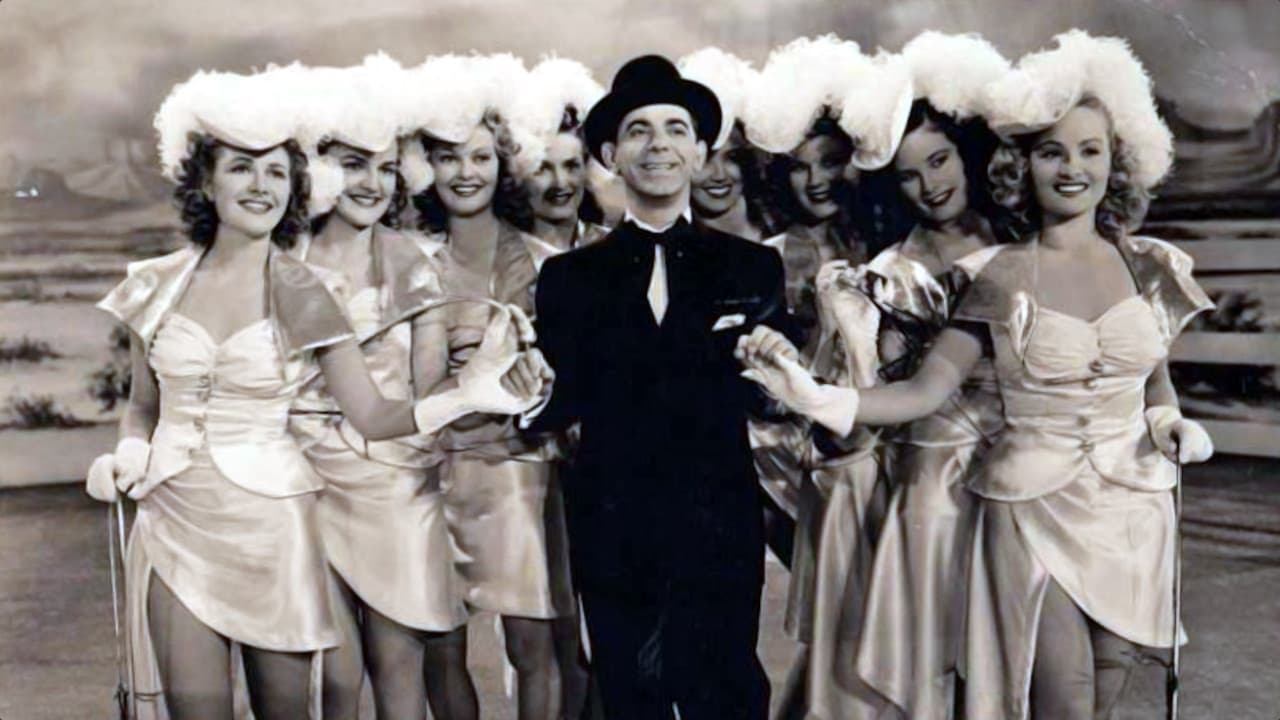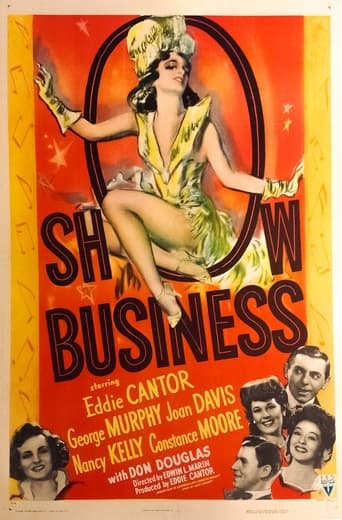Lollivan
It's the kind of movie you'll want to see a second time with someone who hasn't seen it yet, to remember what it was like to watch it for the first time.
Brendon Jones
It’s fine. It's literally the definition of a fine movie. You’ve seen it before, you know every beat and outcome before the characters even do. Only question is how much escapism you’re looking for.
Adeel Hail
Unshakable, witty and deeply felt, the film will be paying emotional dividends for a long, long time.
Kien Navarro
Exactly the movie you think it is, but not the movie you want it to be.
MARIO GAUCI
Another Leslie Halliwell favourite, this period musical follows the pattern of several others of its ilk – the career from obscurity to popularity, hitting the skids and the climb back to the top of a burlesque/vaudeville troupe (apparently, the former is deemed a low- grade art form and despised by the latter, but there is little to differentiate them in this film and elsewhere!). Incidentally, co-star George Murphy – whom the fall from grace hits the hardest here – had also featured in the very similar (also comparable quality-wise) FOR ME AND MY GAL (1942), where it was Gene Kelly who got on the wrong end of fame and fortune.The movie under review was actually instigated by comedian Eddie Cantor (who personally produced it): he had had a successful run of star vehicles with Samuel Goldwyn in the 1930s, followed by a couple of well- regarded efforts for other studios later on – Warners' star-studded THANK YOUR LUCKY STARS (1943) and this one, made over at RKO (its success even prompted a sequel, named after one of Cantor's best-known tunes i.e. IF YOU KNEW SUSIE {1948}). There is actually an autobiographical element to SHOW BUSINESS, since the character he plays obtains his greatest hit with Cantor's very own "Makin' Whoopee" (which inspired his 1930 star vehicle)! Also on hand is comedienne Joan Davis, whose initial disdain for Cantor grows into a true and almost protective love – frequently breaking the fourth wall to assure the viewer that she cannot help herself; their Cleopatra routine is a hoot!The film encompasses comedy, songs (notably the standard "It Had To Be You", sung – either alternately or concurrently – by Murphy and love interest Nancy Kelly), romance (the latter broken up by his former partner, in both senses of the word) and nostalgia and, while neither the classic Halliwell deems it to be (conversely, Leonard Maltin rated it a more modest **1/2) nor Cantor's most representative work (that would be ROMAN SCANDALS {1933}), there is no doubt that it offers solid entertainment throughout and, as stated in an after-credits title-card, was conceived primarily as wartime escapism for American audiences, be they at home or abroad fighting.
jackboot
Eddie, Joan, George and Constance - when did the, now codified, tradition of comics using their real given names for their characters really get started? Latter day examples abound, from Lucy and Ricky, to Everybody Loves Raymond. When did this really get started? Al Jolson's characters were sometimes named "Al" going back into the 1920s. Here the time honored tradition is used four-fold for the quartet of stars in this picture.George Doane (George Murphy) is a successful burlesque performer who meets Eddie Martin (Eddie Cantor) backstage at an amateur night after George's performance. They hit it off, click and team up to be a hard-working and successful duo. Along the way, they meet a sister act, Joan Mason (Joan Davis) and Constance Ford (Constance Moore). George woos Constance relentlessly, while the four join forces as a show business four-some and eventually George and Constance marry. Joan, early on, sets her sights on Eddie who spends the rest of the picture evading her, providing a steady running joke throughout the picture.This four person troupe hits the road and life's ups, and its downs of melodramatic proportions, befall them along the way, some of which are surprisingly serious for such a light and breezy story. All's well that ends well and Eddie and Joan, who do yeoman's duty applying all of the comedic heavy lifting, put a brilliant button on the proceedings at the curtain's close.En route, we are treated to some real classics of Tin Pan Alley, and earlier, tunesmithery. No new songs, but some familiar chestnuts as well as a couple from Eddie Cantor's quiver such as "Making' Whoopee" and "I Don't Want To Get Well", among other American favorites, such as "Dinah", "I Want A Girl (Just Like The Girl Who Married Dear Old Dad)" and even a comic vaudeville treatment of the famous Sextette from Lucy (Lucia di Lammermoor). The charming "It Had To Be You" is sung multiple times, by both romantic leads and woven throughout the score, even converted to a minor mode for the sad moments, and generally is the signature tune for the romance angle of George and Constance throughout the story, from their first meeting to their final reconciliation. The musical numbers are by and large very entertaining and make up the best of this little sojourn through early 20c show business.The "Dinah" number is done in cringe-worthy black-face, though, I must say, if one could ever say such a thing, that it was somehow done elegantly. Cantor and Murphy come out in black-face but smartly dressed in beautiful white satin top hats and tails and present the song nicely and, the black-face notwithstanding, with much dignity. Overall, certainly much better than the troubling treatments of such numbers as "Goin' To Heaven On A Mule" from "Wonder Bar" (1934) or "Abraham" from "Holiday Inn" (1939). Really, the black-face could have been left out, save for the flimsy justification that historically, in the time period of the story, pre-WWI vaudeville, this style of performance would typically have been in evidence. It's regrettable and I wouldn't have missed it at all if the number had been done without the black-face makeup. For today's audience, it is a screaming distraction at the very least and easily much more offensive than any supposed value it might add. Interspersed between the musical numbers are many opportunities for Eddie Cantor's marvelous comedic schtick and Joan Davis' wisecracks and physical gags. They are hilarious and play off of each other very well. Cantor and Davis keep one watching when the story begins to bog down.And bogging down the proceedings are the romantic leads, Constance Moore and George Murphy. Murphy comes across as a little too thinly veneered and lightweight in the acting skills department to really carry the melodrama quotient to any meaningfully felt level. The George Doane character comes across as likable enough though he simply cannot evince any great pathos that might move the viewer to feel anything much in the way of empathy. Constance Moore was, sadly, very disappointing. She comes across as rather cold and cross too much of the time without giving much in the way of a warm and loving payoff, much needed and sorely lacking, to allow the audience to fall in love with her as well as to bring this story all the way home to its happy conclusion.The story, lacking much meat on its bones, doesn't give us thoughtful lead-ins or transitions through the many ups and downs of our four-some on the boards. Some plot turns come seemingly from out of nowhere and are as such rather jarring, leaving the viewer puzzled. It is almost as if the writers decided "okay, now we have to have boy lose girl" without first laying much in the way of proper groundwork. The wrap up feels slapped on and the happy ending comes too easily for the audience to feel that the characters earned it, but, by the end, all surely is well that ends well.In the final reckoning, what makes this film a delight to watch and a fine relic worthy of being preserved is that we get another opportunity, with better and more modern production values than were available in the early 1930s, to see Eddie Cantor masterfully work through some comic business and it is his contributions, along with those of Joan Davis, which really make this film a must see - right up to the curtain's close!I give this a generous 8 out of 10 stars largely on the strength of this being one more rare example to be able to see Cantor work his magic.
ptb-8
This very funny and often very rude musical comedy is basically a biography of a burlesque to vaudeville song and dance team over the first 30 years of the 20th century. Produced in 1944 by RKO it forms part of the series of looser censorship titles that seemed to find some freedom to be more realistic (with a franker sexuality) during the war years. It is also part of the nostalgia mentality of WW2. SHOWBUSINESS is not a WW2 film but one made to shore up reasons why America fought, displaying a warm hearted Americana that justifies the American spirit - on stage in crummy burlesque and splashier vaudeville. The main stars are the unconvincing grinning George Murphy, always awkward and odd especially when tap dancing and the reliable and then retired 30s mega star Eddie Cantor who I personally find hilarious. Pratfall queen and camp comedienne Joan Davis becomes Edde's love interest: but... in this film Eddie's character is so clearly gay (the script makes no doubt he is both a sissy and not interested in a female lover that it is up to Joan to constantly turn to the camera and exclaim "but I just love that boy" chasing and embracing him while he squirms, even to the final fade out. One genuinely laugh out loud gag between them involves a massive salami...since she knows what Eddie likes. The dance numbers are pedestrian and just a blip above curiosity and there are so many montages using RKO musical stock footage that they almost take over the interest in the film, picking what obscure old title they have been lifted from. However, Joan and Eddie provide such a font of vulgar sex jokes and sly camp farce that they save the film from being bland. Oddly enough with all the vulgar jokes on hand, the Eddie Cantor song 'Makin Whoopee" is delivered in a slurred tone as if not to make such a big obvious deal of what 'makin whoopee' is actually referring to. A case of when the 1930 rendition is better than the 1944 one.
Esther
And wit like you would never see nowadays.The story of a four person act, two men Eddie Martin (Eddie Cantor) and George Doane (George Murphy) and two women Joan Mason (Joan Davis) and Constance Ford (Constance Moore) (lot of thought evidently went into those names), their lives, their loves, their highs, their lows and some very entertaining performances. Particularly from Joan Davis who gets all the fabulous one-liners.There a some classic songs in there too, "Making Whoopee" and "It Had To Be You." All in all, a very entertaining way to spend a slow Saturday afternoon.

